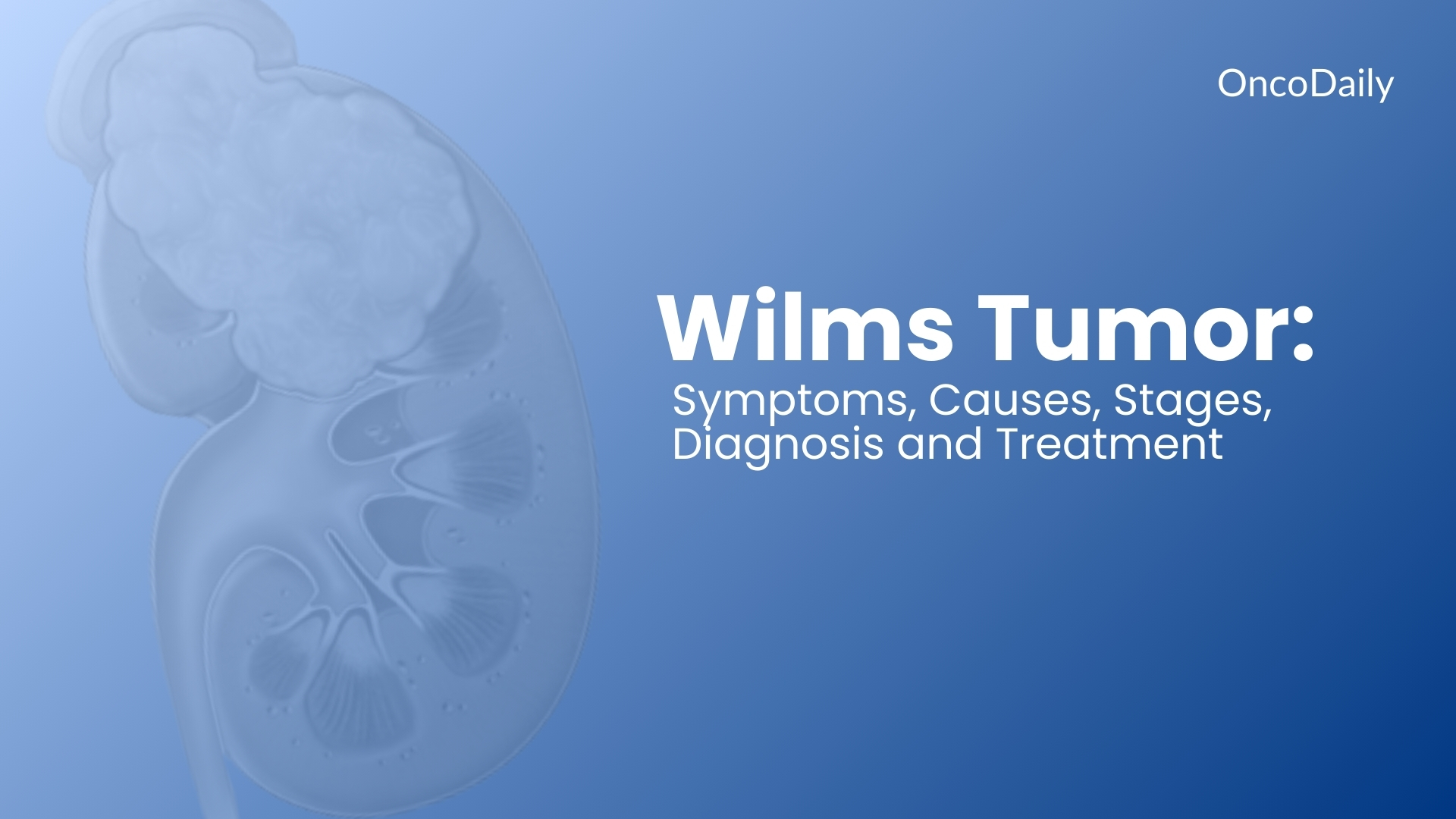Wilms tumor, or nephroblastoma, is a rare yet significant type of kidney cancer primarily affecting children under the age of 5. It accounts for approximately 6-7% of all childhood cancers, making it one of the most common pediatric renal malignancies. Early detection and treatment have dramatically improved outcomes, with a 5-year survival rate exceeding 90% for cases localized to the kidney, according to the American Cancer Society and the Children’s Oncology Group.
This article will explore the key aspects of Wilms tumor, including its symptoms, causes, types, diagnosis, stages, and treatment options. By understanding these critical factors, we can better address the challenges of managing this pediatric cancer and highlight the advancements that continue to improve outcomes for young patients worldwide.
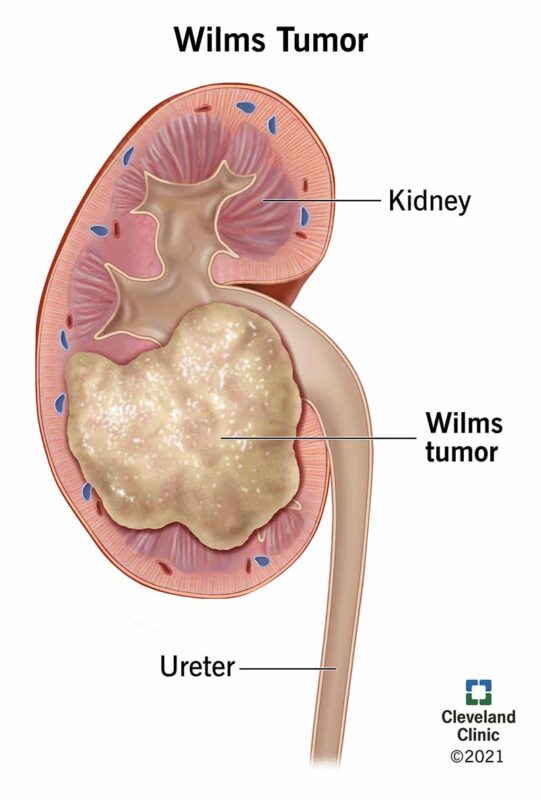
What Are the Symptoms of Wilms Tumor?
Common symptoms of Wilms tumor include abdominal swelling or a palpable mass, which is often painless and typically discovered incidentally by parents or during routine pediatric check-ups. Other symptoms include blood in the urine (hematuria), fever, and loss of appetite, sometimes accompanied by fatigue or irritability.
As reported by the Children’s Oncology Group and data cited in the Journal of Pediatric Hematology/Oncology, abdominal swelling is observed in approximately 80% of cases at diagnosis. Hematuria occurs in about 25%, while systemic symptoms like fever and appetite loss are seen in fewer than 15% of patients. These statistics emphasize the need for prompt evaluation of early signs to improve treatment outcomes.
What Are the Early Signs of Wilms Tumor?
Early signs of Wilms tumor often include an asymptomatic abdominal mass, typically discovered incidentally during bathing or dressing, and elevated blood pressure (hypertension), caused by the tumor’s pressure on the kidneys or surrounding vessels. These subtle signs can complicate early detection, as they may not initially cause discomfort or prompt immediate medical evaluation.
For instance, a case series published by Turner et al. in Pediatric Nephrology (2024) detailed instances where children presented with mild hypertension and a non-tender abdominal mass, leading to a delayed diagnosis. However, early identification in several cases through routine check-ups significantly improved outcomes.
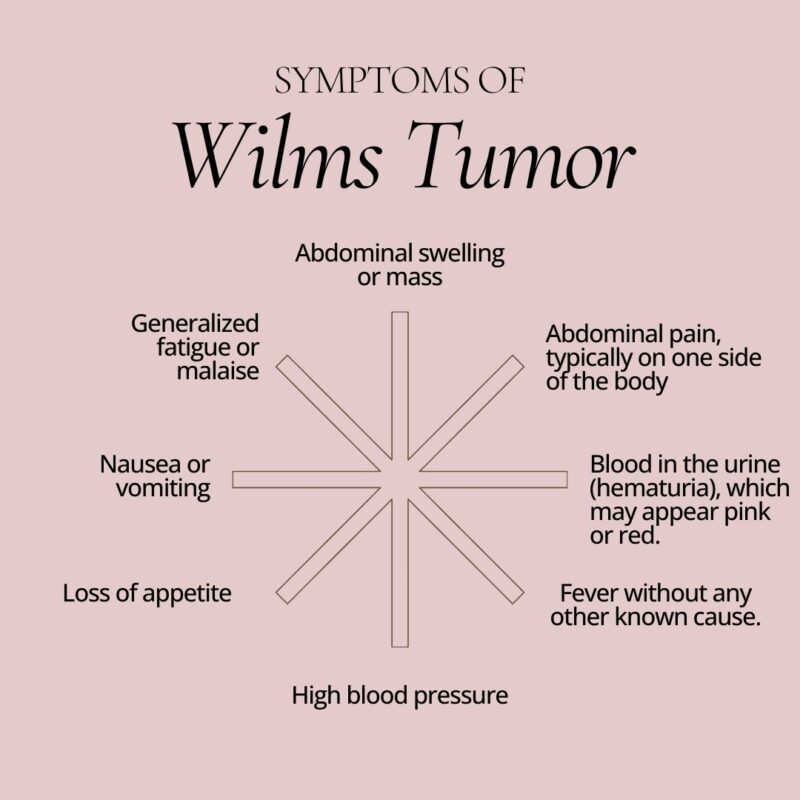
What are the Causes and Risk Factors for Wilms Tumor?
Wilms tumor is strongly associated with genetic mutations, particularly in the WT1 and WT2 genes, which play vital roles in kidney development. Mutations in these tumor suppressor genes disrupt normal cellular growth, leading to unchecked proliferation and tumor formation. Inherited syndromes such as renal malignancies., Beckwith-Wiedemann syndrome, and Denys-Drash syndrome significantly increase the likelihood of developing Wilms tumor.
WAGR syndrome (Wilms tumor, Aniridia, Genitourinary anomalies, and intellectual disability) is caused by deletions on chromosome 11p13, which encompass the WT1 gene. According to data from MedlinePlus Genetics, children with WAGR syndrome face a 45-60% lifetime risk of developing Wilms tumor.Beckwith-Wiedemann syndrome, linked to alterations in the WT2 locus on chromosome 11p15, leads to overgrowth and a heightened cancer risk, with approximately 5-10% of affected children developing Wilms tumor. This syndrome is often accompanied by features such as macroglossia (enlarged tongue) and hemihypertrophy (asymmetric body growth), which alert clinicians to the need for regular tumor monitoring. Denys-Drash syndrome, caused by mutations in the WT1 gene, is marked by gonadal dysgenesis and nephropathy. Nearly 90% of children with this syndrome develop Wilms tumor, making it one of the highest-risk genetic conditions and highlighting the importance of proactive monitoring.
What Are the Types of Wilms Tumor?
Wilms tumor is classified into two main types based on its histological features: favorable histology and anaplastic (unfavorable) histology. Favorable histology, which accounts for the majority of cases, is characterized by the absence of cellular abnormalities, offering better treatment outcomes. In contrast, anaplastic histology is marked by the presence of abnormal, resistant cells and is associated with a poorer prognosis. These distinctions guide treatment planning and are critical for predicting patient outcomes.
Favorable Histology Wilms Tumor
Favorable histology Wilms tumor is the most common type, accounting for approximately 90% of all Wilms tumor cases, according to data from the Children’s Oncology Group and the American Cancer Society. This type lacks significant cellular abnormalities, allowing it to respond exceptionally well to standard treatments.
Survival rates for favorable histology Wilms tumor are highly encouraging. For localized cases, the 5-year survival rate exceeds 90%, while even children with advanced but treatable disease achieve excellent outcomes with aggressive multimodal treatment. These success rates highlight the importance of early diagnosis and adherence to established treatment protocols to ensure optimal outcomes.
Anaplastic Histology Wilms Tumor
Anaplastic Wilms tumor, also known as unfavorable histology Wilms tumor, is a more aggressive form of the disease characterized by abnormal, resistant tumor cells. These cells exhibit nuclear anaplasia, meaning they have enlarged, irregular nuclei that contribute to rapid and uncontrolled growth, making this type more difficult to treat.
Survival statistics for anaplastic Wilms tumor are notably lower compared to favorable histology cases. According to data from the Children’s Oncology Group, the 5-year survival rate for children with localized anaplastic tumors is approximately 70-75% when treated with surgery, chemotherapy, and radiation therapy. However, for cases with metastasis or diffuse anaplasia, survival drops significantly, with rates closer to 30-40%, depending on the response to treatment and the extent of the disease.
Early and aggressive treatment, along with tailored therapeutic approaches, is essential for improving outcomes in this more challenging form of Wilms tumor. Ongoing research focuses on refining treatment strategies to enhance survival and quality of life for these patients.
How Is Wilms Tumor Diagnosed?
Diagnosing Wilms tumor requires a combination of physical examination, imaging tests, and biopsy to confirm the presence and extent of the disease. Since early symptoms can be subtle or mistaken for other conditions, timely detection is critical for successful treatment.
Physical Examination and Medical History
Diagnosing Wilms tumor typically begins with a thorough physical examination, during which a healthcare provider palpates the abdomen to check for a mass, swelling, or tenderness. Since Wilms tumor often presents as a painless abdominal lump, this initial assessment is crucial in identifying potential concerns.In addition to the physical exam, the provider takes a detailed medical history, asking about symptoms such as abdominal swelling, blood in the urine (hematuria), fever, loss of appetite, or unexplained weight loss. These findings help determine whether further diagnostic testing is needed.
If an abdominal mass is detected or symptoms raise suspicion of Wilms tumor, the provider will recommend imaging tests to confirm the presence and extent of the tumor. Early identification at this stage significantly improves treatment success, as prompt follow-up testing ensures the cancer is detected before it spreads.
Imaging Tests: Ultrasound, CT, and MRI Scans
The diagnosis of Wilms tumor involves a combination of imaging modalities to accurately determine the presence, size, and location of the tumor, which is crucial for effective treatment planning.
- Ultrasound (US): Often the initial imaging test, ultrasound is non-invasive and free of ionizing radiation. It effectively identifies renal masses and assesses their characteristics. A study published in the Journal of Clinical Imaging Science reported that ultrasound has a diagnostic accuracy of approximately 95% in detecting Wilms tumor. However, its sensitivity decreases in identifying tumor extension into adjacent structures or detecting small metastatic lesions.
- Computed Tomography (CT): CT scans provide detailed cross-sectional images, offering superior evaluation of tumor extension, lymph node involvement, and distant metastases. According to research in the American Journal of Roentgenology, CT demonstrated a diagnostic accuracy of 82% in preoperative identification of Wilms tumor. CT is particularly valuable in staging the tumor and planning surgical interventions.
- Magnetic Resonance Imaging (MRI): MRI offers excellent soft-tissue contrast without ionizing radiation, making it useful for assessing tumor invasion into blood vessels and surrounding tissues. A study in Cancer Imaging highlighted MRI’s effectiveness in evaluating renal vein and inferior vena cava involvement, with a sensitivity of 100% and specificity of 90%.
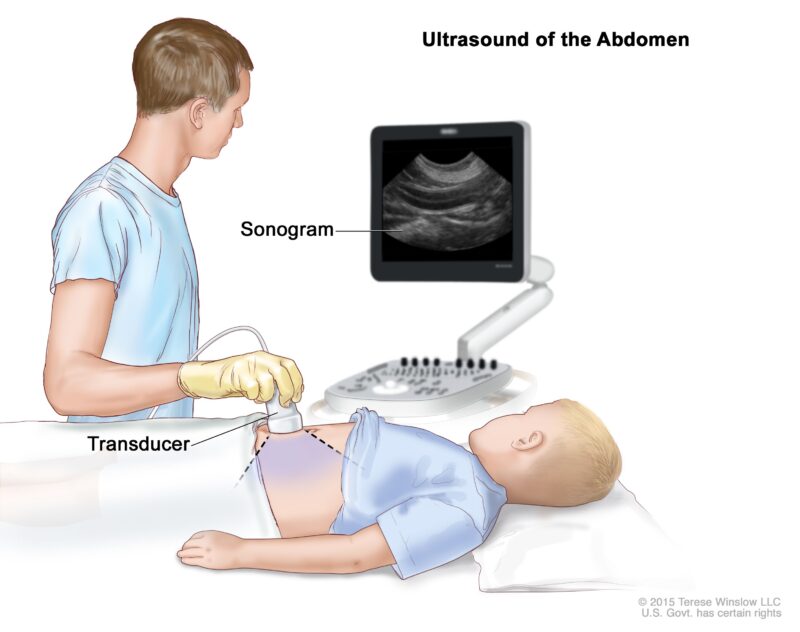
Biopsy and Pathological Examination
When imaging studies suggest the presence of a Wilms tumor, a biopsy may be performed to obtain a definitive diagnosis. This procedure involves extracting a small tissue sample from the suspected tumor, which is then examined under a microscope by a pathologist. The analysis focuses on identifying the characteristic triphasic cellular composition of Wilms tumor: blastemal, epithelial, and stromal elements.
Histological examination of the biopsy sample is crucial for differentiating Wilms tumor from other pediatric renal neoplasms, such as clear cell sarcoma of the kidney, rhabdoid tumor, and congenital mesoblastic nephroma. Accurate identification ensures appropriate treatment planning.
Furthermore, histological analysis determines the tumor’s classification into favorable or unfavorable (anaplastic) histology. Favorable histology indicates a better prognosis and typically involves standard treatment protocols, while the presence of anaplasia—characterized by enlarged, hyperchromatic nuclei and atypical mitotic figures—suggests a more aggressive disease course, necessitating intensified therapy.
Genetic Testing for Wilms Tumor
Genetic testing plays a crucial role in the diagnosis and management of Wilms tumor, particularly for patients with a family history of genetic syndromes associated with the disease. Mutations in the WT1 and WT2 genes are key contributors to Wilms tumor development, and identifying these mutations helps guide risk assessment, surveillance, and treatment planning. The WT1 gene, located on chromosome 11p13, acts as a tumor suppressor essential for normal kidney and gonadal development. Mutations or deletions in this gene are strongly linked to syndromes that significantly increase the risk of Wilms tumor. In WAGR syndrome (Wilms tumor, Aniridia, Genitourinary anomalies, and intellectual disability), deletions involving WT1 lead to a high lifetime risk of developing the tumor. Similarly, Denys-Drash syndrome, caused by specific WT1 mutations, is associated with early-onset nephropathy and gonadal dysgenesis, with nearly 90% of affected children developing Wilms tumor (PubMed, 2023).
The WT2 locus on chromosome 11p15 is another critical genetic region linked to Wilms tumor, particularly in Beckwith-Wiedemann syndrome (BWS). This overgrowth disorder results from imprinted gene dysregulation in the WT2 region, leading to an increased risk of Wilms tumor alongside other malignancies. Children with BWS require frequent tumor surveillance, as approximately 5-10% develop Wilms tumor (Nature Genetics, 2023).Genetic testing helps identify these high-risk patients early, allowing for personalized surveillance strategies. Children with confirmed WT1 or WT2 mutations benefit from regular abdominal ultrasounds to detect tumors at an early, more treatable stage. Early detection is vital, as studies indicate that over 10% of Wilms tumor cases arise in children with an underlying genetic predisposition syndrome (PubMed, 2024).
Beyond risk assessment, genetic profiling informs treatment decisions. For example, children with WT1 mutations may have a higher likelihood of bilateral Wilms tumor, influencing surgical planning to preserve kidney function. Identifying anaplastic histology through genetic markers also helps determine whether intensified chemotherapy and radiation are necessary to improve outcomes.
Blood and Urine Tests
Blood and urine tests are essential in evaluating kidney function and overall health in children with Wilms tumor. These tests help assess the extent of the disease and determine if the tumor has impacted renal function or other systems.
Blood tests such as serum creatinine and BUN measure kidney filtration, while electrolyte levels detect imbalances. Elevated values may indicate impaired kidney function or tumor-related complications. Urine tests, including urinalysis and proteinuria screening, help identify hematuria (blood in urine) or protein loss, which can signal kidney damage.
What Are the Treatment Options for Wilms Tumor?
The treatment of Wilms tumor typically involves a multimodal approach, combining surgery,chemotherapy, and radiation therapy based on the tumor stage and histology. Nephrectomy (surgical removal of the affected kidney) is the primary treatment for most cases, aiming to eliminate the tumor while preserving renal function when possible. Chemotherapy is administered before or after surgery to shrink the tumor, eliminate residual cancer cells, and reduce the risk of recurrence. In advanced cases or those with unfavorable histology, radiation therapy is used to target remaining cancer cells and improve treatment outcomes.
Surgery for Wilms Tumor
In the surgical management of Wilms tumor, two primary procedures are considered: radical nephrectomy and partial nephrectomy. Radical Nephrectomy involves the complete removal of the affected kidney, surrounding fatty tissue, and occasionally adjacent structures such as the adrenal gland and regional lymph nodes. This approach is standard for unilateral Wilms tumors without predisposing factors for bilateral disease.The statement regarding a mean survival rate of approximately 90.6% following radical nephrectomy in children with Wilms tumor, with a mean follow-up of 5.9 years, is supported by a study published in Frontiers in Oncology. This study evaluated the effectiveness of nephron-sparing surgery and radical nephrectomy, reporting a mean survival rate of 90.6% over an average follow-up period of 5.9 years.
Partial Nephrectomy, or nephron-sparing surgery, entails excising only the tumor and a margin of healthy tissue, preserving the remainder of the kidney. This procedure is particularly appropriate for patients with bilateral Wilms tumors, a solitary kidney, or conditions predisposing them to multiple tumors, where maintaining renal function is crucial.
Chemotherapy for Wilms Tumor
Chemotherapy is a cornerstone in the treatment of Wilms tumor, particularly in advanced stages. It is commonly administered after surgery to eliminate residual cancer cells and reduce the risk of recurrence. In certain cases, chemotherapy may be given before surgery to shrink large tumors, facilitating safer and more effective surgical removal.The specific chemotherapy regimen depends on factors such as the tumor’s stage and histology. Commonly used drugs include vincristine, dactinomycin, and doxorubicin. For advanced-stage tumors, more intensive regimens may be employed to improve outcomes.
According to the American Cancer Society, the 4-year survival rates for Wilms tumor vary by stage and histology. For instance, children with stage IV favorable histology tumors have a 4-year survival rate of approximately 90% to 100%. However, those with stage IV diffuse anaplastic tumors have a lower 4-year survival rate, ranging from 30% to 70%.
Chemotherapy can lead to various side effects due to its impact on both cancerous and healthy cells. Common side effects include hair loss, nausea, vomiting, loss of appetite, and fatigue. The severity and duration of these side effects depend on the specific drugs used and the individual patient’s response. For example, vincristine can cause peripheral neuropathy, leading to tingling or numbness in the extremities, while doxorubicin carries a risk of heart damage, particularly at higher cumulative doses.
Recent advancements in Wilms tumor treatment have focused on targeted therapies and immunotherapies to improve outcomes, especially in high-risk cases.According to a 2024 study by Choochuen et al. published in Cancers, exome sequencing of 43 Wilms tumor samples identified mutations in genes such as ALPK2, C16orf96, PRKDC, and SVIL that correlate with chemotherapy resistance. These findings suggest that targeting these mutations with specific agents could overcome resistance and improve treatment efficacy.
A 2024 narrative review in Cancer Immunology, Immunotherapy highlighted the development of WT1-targeted peptide vaccines. Phase I/II clinical trials have demonstrated their safety and efficacy across various cancers, including Wilms tumor. The combination of these vaccines with immune checkpoint inhibitors has shown synergistic effects, enhancing anti-tumor responses.
What Are the Stages of Wilms Tumor?
The staging system for Wilms tumor helps determine the extent of the disease and guides treatment decisions. Stages range from Stage I (localized) to Stage V (bilateral kidney involvement), each with different treatment approaches and prognosis.
- Stage I: The tumor is completely confined to the kidney and has been completely removed with surgery. The kidney capsule remains intact, and there is no spread to blood vessels or nearby structures. Survival rates exceed 90% with surgery and chemotherapy.
- Stage II: The tumor has extended beyond the kidney but has been fully removed. It may have invaded nearby tissues, such as the renal sinus or blood vessels, but there is no lymph node involvement. Standard treatment includes surgery followed by chemotherapy, with survival rates around 85-90%.
- Stage III: Cancer has spread to regional lymph nodes or has invaded major blood vessels, but has not metastasized to distant organs. Complete surgical removal is not possible, requiring additional radiation therapy along with chemotherapy. The 4-year survival rate is about 85%.
- Stage IV: The cancer has metastasized to distant organs, such as the lungs, liver, or brain. Treatment involves more aggressive chemotherapy and radiation, in addition to surgery. The prognosis varies significantly depending on histology, with survival rates ranging from 60-90% for favorable histology and 30-70% for anaplastic tumors (American Cancer Society, 2024).
- Stage V: Both kidneys are affected at diagnosis (bilateral Wilms tumor). Treatment focuses on nephron-sparing surgery, followed by chemotherapy to shrink the tumor before attempting surgery. Long-term survival depends on preserving kidney function and controlling tumor progression, with survival rates around 70-90% for favorable histology cases (Children’s Oncology Group, 2024).
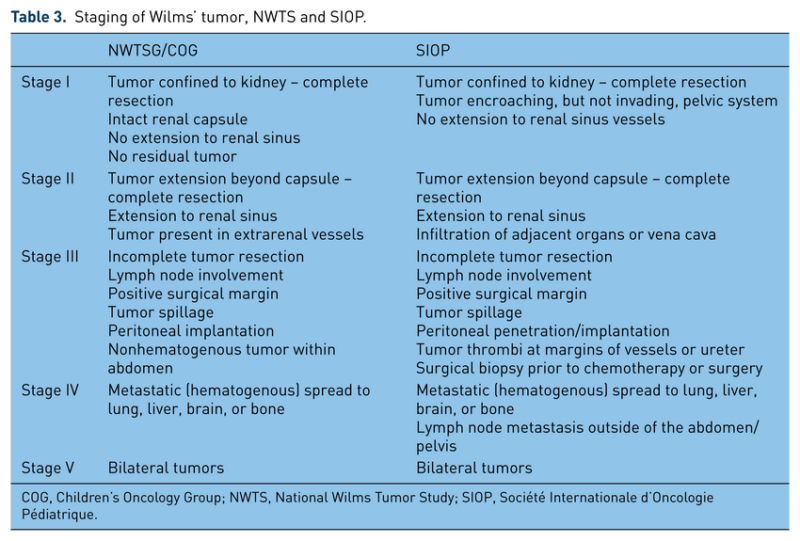
After Treatment: What to Expect
The post-treatment phase of Wilms tumor focuses on physical recovery, managing side effects, and long-term monitoring. Patients recovering from surgery and chemotherapy may experience fatigue, appetite changes, and weakened immune function, while those who received radiation therapy may have growth delays or organ damage.Kidney function monitoring is essential, especially for patients who underwent partial nephrectomy or had bilateral disease (Stage V). Chronic kidney disease (CKD) is a concern, requiring regular blood tests and blood pressure monitoring to detect early signs of dysfunction.
Surveillance for recurrence involves routine imaging (ultrasounds, CT scans) and lab tests, particularly in the first two years post-treatment, when relapse risk is highest. Children’s Oncology Group (2024) guidelines recommend lifelong follow-ups for survivors due to potential late effects of chemotherapy and radiation, such as secondary cancers or heart complications.
How Is Wilms Tumor Prognosis Determined?
The prognosis of Wilms tumor depends on tumor stage, histology, and patient health. Early-stage tumors (Stages I and II) have a 5-year survival rate exceeding 90%, while Stage IV cases have a 4-year survival rate of approximately 86% .Histology plays a key role—favorable histology cases have high survival rates, whereas anaplastic histology, seen in 5-10% of cases, is associated with poorer outcomes due to treatment resistance (ASCO, 2024).
Recent advancements in treatment, including targeted therapies and refined chemotherapy protocols, have further improved survival, though certain subgroups, such as anaplastic histology cases, still require better strategies (PMC, 2024).
How Long Does It Take to Notice and Cure Wilms Tumor?
The timeline for Wilms tumor diagnosis and treatment varies by stage. Symptoms such as abdominal swelling or hematuria typically prompt a medical visit within weeks, followed by imaging (ultrasound, CT, MRI) and biopsy, leading to diagnosis within 1-2 weeks.
Treatment starts immediately—surgery (nephrectomy) is often performed within days to weeks after diagnosis. Chemotherapy for early-stage tumors lasts 4-6 months, while advanced-stage cases require up to a year of chemotherapy and radiation.
Recovery varies—patients with Stage I-II tumors recover fully within months, while Stage III-IV cases require longer follow-ups due to treatment side effects. Long-term prognosis is excellent, with a 5-year survival rate of 90%+ for favorable histology but lower for anaplastic cases (50-70%) (Children’s Oncology Group, 2024). Lifelong monitoring is recommended for kidney function and secondary cancers.
Can Wilms Tumor Be Prevented?
Preventive measures for Wilms tumor focus on genetic screening for high-risk families, especially those with WAGR, Beckwith-Wiedemann, or Denys-Drash syndromes. Experts recommend routine abdominal ultrasounds every 3-6 months for early detection in at-risk children (Children’s Oncology Group, 2024).
Lifestyle changes, such as a balanced diet and avoiding environmental toxins, may support overall kidney health but do not directly prevent Wilms tumor. Early detection through regular check-ups improves treatment outcomes, especially for genetically predisposed children.
You Can Watch More on OncoDaily Youtube TV
Written by Toma Oganezova, MD
FAQ
What is Wilms Tumor and Who Does It Affect?
Wilms tumor, also known as nephroblastoma, is a rare kidney cancer that primarily affects children, most commonly under the age of five. It is one of the most prevalent pediatric renal malignancies and accounts for about 6-7% of all childhood cancers.
What Are the Common Symptoms of Wilms Tumor?
Symptoms of Wilms tumor include a painless abdominal mass, swelling, hematuria (blood in urine), fever, high blood pressure, nausea, and loss of appetite. In many cases, the tumor is discovered during routine pediatric check-ups.
What Causes Wilms Tumor?
Wilms tumor is often linked to genetic mutations, particularly in the WT1 and WT2 genes, which regulate kidney development. Some children inherit these mutations or develop them due to conditions like WAGR syndrome, Beckwith-Wiedemann syndrome, and Denys-Drash syndrome.
How Is Wilms Tumor Diagnosed?
Diagnosis involves a combination of physical exams, ultrasound, CT scans, MRI, biopsy, and genetic testing. Imaging helps determine tumor size and spread, while a biopsy confirms cancer type and histology.
What Are the Treatment Options for Wilms Tumor?
Treatment involves a combination of surgery (nephrectomy), chemotherapy, and radiation therapy based on the tumor stage and histology. Favorable histology cases have a high success rate with treatment.
What Is the Survival Rate for Wilms Tumor?
Wilms tumor has a high survival rate, with over 90% five-year survival for localized cases. However, prognosis depends on the tumor's stage, histology, and patient response to treatment.
Can Wilms Tumor Recur After Treatment?
Yes, recurrence can occur, especially in cases with anaplastic histology. Regular follow-up with imaging and lab tests is essential to monitor for relapse and manage any long-term side effects.
Are There Any Long-Term Effects of Wilms Tumor Treatment?
Some children experience kidney function issues, growth delays, or heart complications due to chemotherapy and radiation. Lifelong monitoring is recommended to manage potential late effects.
Can Wilms Tumor Be Prevented?
Wilms tumor cannot be entirely prevented, but early detection through regular check-ups and genetic screening in high-risk children (those with syndromic conditions) improves outcomes.
Is Wilms Tumor Hereditary?
Wilms tumor is usually not inherited, but in some cases, it is linked to genetic syndromes such as WAGR syndrome, Beckwith-Wiedemann syndrome, and Denys-Drash syndrome. Children with a family history of Wilms tumor or these syndromes may have an increased risk and should undergo regular medical screenings for early detection.
